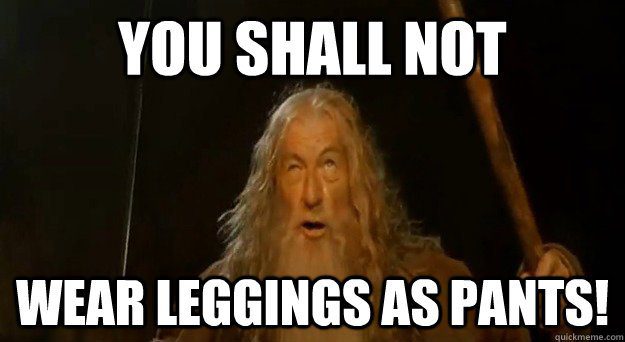
United Airlines stepped into a social media firestorm yesterday when a story about passengers were denied boarding on a flight from Denver to Minneapolis because they were wearing leggings hit the internet.
The story started to blow up on Twitter when a passenger on another flight saw this happening at the gate and send these tweets to @United.

As this was playing out in real time on Twitter, people jumped to conclusions and had opinions before all the details were in, including United’s Twitter team.

As it turns out, the passengers in question were flying on non-revenue (non-rev) tickets. These are available to family members and friends of airline employees and do have more restrictions and guidelines than regular tickets. The passengers were not following the dress code and asked to change by the agent at the gate. This was the original action that prompted the Tweets in the first place.
Now that it’s a day since the events and we have most of the important details, lets see what we’ve learned from this experience.
What’s a non-revenue (non-rev) passenger?
Essentially, it’s someone flying for free or at an extremely reduced price. It is a perk given to employees of the airline that lets family and friends fly, usually on a space available basis. Since, when traveling on these tickets, you are representing the airline there are guidelines that you are supposed to follow, including a quite detailed dress code. Here is the dress code for United:
- Pass riders’ overall appearance should be well-groomed, neat, clean and in good taste.
- Attire should be respectful of fellow revenue passengers, employees and pass riders.
- Pass riders may wear denim attire (such as jeans), shorts that are no more than three inches above the knee and athletic shoes when traveling in Coach or Business cabin.
The following attire is unacceptable in any cabin but is not limited to:
- Any attire that reveals a midriff.
- Attire that reveals any type of undergarments.
- Attire that is designated as sleepwear, underwear, or swim attire.
- Mini Skirts
- Shorts that do not meet 3 inches above the knee when in a standing position.
- Form-fitting lycra/spandex tops, pants and dresses.
- Attire that has offensive and/or derogatory terminology or graphics.
- Attire that is excessively dirty or has holes/tears.
- Any attire that is provocative, inappropriately revealing, or see-through clothing.
- Bare feet
- Beach-type, rubber flip-flops
I have a relative who works for an airline and I’ve flown as a non-revenue passenger, albeit many years ago. It’s not a glamorous way to travel because you really are at the mercy of the airline for your trip. We were informed by my relative ahead of time about the dress code and what to expect when traveling. We had to wait until the whole plane was loaded to see if there seats. We had no choice of seat assignments. Even if we were on the plane, they could come and tell us to get off because a paying passenger needed the seat, right up to when the door was closed. We were never to complain about anything because the employee who gave you the passes could get in trouble if their guests act inappropriately. As it turned out, we had to wait for 3 planes to find one with open seats and spent the whole day at the airport. For the return trip, we had to drive 4 hours to another airport to get a flight home. We never flew that way again.
It wasn’t wrong to make them change clothes
As many people who have flown as non-rev passengers pointed out to me, it was not wrong to force these passengers to change clothes. Everyone who uses these type of tickets knows, or should know, the rules. By showing up inappropriately dressed, they were breaking the rules. If some people can follow the rules, then everyone should have to.
I totally agree. Rules are rules. Now I don’t know what actually happened at the airport. Was the gate agent polite about reminding them about the dress code or were they snooty about it?

We all know that in situations like this, it is the approach that you take and not the message you are delivering that makes all the difference in how the interaction goes. I’m not going to start to form opinions on this one because it wasn’t even the passengers who were writing United, but people observing the situation. However, you figure if it was enough of a scene for others to notice, then it must have been more than a polite request to change clothing and the passengers being totally accommodating. I’ll leave it at that.
How thoughtless customer service makes things worse
Here’s one of the big takeaways from this whole event. The initial response by the United Twitter team was one of the reasons why this story went viral. The knee-jerk response that the gate agent was correct and had the right to deny boarding to anyone based on the legal Contract of Carriage. You know, the contract that no one reads that says the passenger has no rights and the airlines can do whatever they want was the basis they used on Twitter to justify making passengers change or cover up their leggings because they were”not properly clothed.”
As the story developed and more details came to light, United tried to walk back and point out, correctly, about how these passengers were non-rev and therefore have specific dress guidelines. United has even gone as far as to post on their website.

You know you’ve messed up when you need to write this headline.
This doesn’t keep me from feeling that the first response was to stick up for the employee. While this may be a gut instinct for most people, it is not prudent for those on the front lines of customer service. Your job is to collect information, listen and then act appropriately but apparently, this is not United’s first response to customer comments. Instead they seem to feel the customer is always wrong unless you can prove otherwise. In hindsight, a comment like “Thanks for your observation. We will be notifying airport staff and get details of this interaction. We will follow up when we know more.” (I checked, it’s less than 140 characters).
Are United’s guidelines outdated?
I’ve read comments on Twitter and the internet accusing United’s non-rev dress code as being sexist. While many of the guidelines are unisex, they are more guidelines telling women how to dress. I’ll leave it to you to decide.
One Mile at a Time wrote an article today about the different non-rev dress codes and if, in comparison, United’s looks sexist. It is interesting to read how different the airlines policies are for the same issue.
Final Takeaway
I found this an interesting story to follow with so many moving parts. From the initial story and the conclusions people were making before the whole story was available. Then the initial response from United and the subsequent attempts to correct the damage. The response of those who followed the rules and how they felt about those who didn’t. How people who wear leggings were mad about being told how to dress. How people that don’t wear leggings feel they are not appropriate in certain situations. Finally, how bringing the guidelines to the open is now questioning if they are still relevant to today.
I’d like to thank the websites View from the Wing, One Mile at a Time and Points Guy for the updates yesterday on this story.
How do you feel about the whole thing?

1 comment
[…] more comfortable. United has gotten a lot of bad press recently, and with good reason (this and this, for example). At least this is finally something positive that can be said about […]